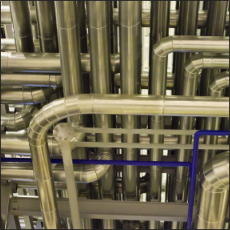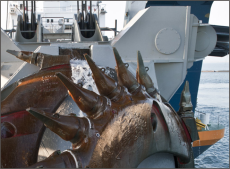Steel Projects
Control system for aluminum web anodizing line with database server interface
SUMMARY: The anodizing line uses a programmable logic controller (PLC) and a human machine interface workstation (HMI) for process control. A Microsoft SQL Server database was used for production setup and process information storage.
DESCRIPTION: The line has an unwind stand, several washing and rinsing tanks, an anodizing tank, intermediate and main pull roll stands and a center driven rewind. Control enclosures for each line contain the line drives (AC vector drives), the PLC and the HMI workstation. The PLC controls various temperature, flow, level, pH and conductivity loops in the wash and rinse tanks. The PLC controls the amperage of the anodizing probes. The PLC monitors unwind roll diameter and varies pneumatic brake pressure to maintain a constant unwind tension independent of roll diameter. The PLC controls speed references to the intermediate and main pull roll drives to create tension draw control. The PLC sends a torque setpoint with a taper bias to the rewind roll drive operating in torque control mode. This allows the rewind to create tight rolls with less tension as roll diameter increases, eliminating roll telescoping.
An HMI workstation allows an operator to select the product to run. The product information is queried from a central database server and used to automatically setup the PLC for the production run. Once selected, the operator starts the run and the PLC/HMI inserts real-time process information back to tables in the database server. Linked tables from a local database in the production office provide the production scheduler with the means of inserting production information into the database server. Automatic report generation is accomplished by querying information from the process information stored in the database.
Gas Fired Hearth Furnace Control System
SUMMARY: Developed a 20 burner, 7 Zone combustion control system for a steel annealing rotary Hearth Furnace using PLC control and HMI interface.
DESCRIPTION: The PLC monitors and maintains zone temperature setpoints by controlling combustion air dampers and gas valves. The system continuously monitors interlocks for safety and shutdown circumstances. Each zone has fuel valve and combustion air PID control to allow smooth start-up and shut down. Cascade PID control is used to allow combustion air to follow the fuel control while maintaining a safe gas to air ratio. Logic was developed to allow Bumpless transition from automatic to manual control. The furnace pressure is maintained at a slightly negative value by controlling the induced draft fan speed. The operator has complete manual and automatic control of the system through the graphical HMI. All alarms and events are recorded to a database and printed as they occur.
Logic is incorporated to monitor PLC input and output modules for failures.
Control system for three aluminum web coating lines with common database server
SUMMARY: The anodizing line uses a programmable logic controller (PLC) and a human machine interface workstation (HMI) for process control. A Microsoft SQL Server database was used for production setup and process information storage.
DESCRIPTION: The line has an unwind stand, several washing and rinsing tanks, an anodizing tank, intermediate and main pull roll stands and a center driven rewind. Control enclosures for each line contain the line drives (AC vector drives), the PLC and the HMI workstation. The PLC controls various temperature, flow, level, pH and conductivity loops in the wash and rinse tanks. The PLC controls the amperage of the anodizing probes. The PLC monitors unwind roll diameter and varies pneumatic brake pressure to maintain a constant unwind tension independent of roll diameter. The PLC controls speed references to the intermediate and main pull roll drives to create tension draw control. The PLC sends a torque setpoint with a taper bias to the rewind roll drive operating in torque control mode. This allows the rewind to create tight rolls with less tension as roll diameter increases, eliminating roll telescoping.
An HMI workstation allows an operator to select the product to run. The product information is queried from a central database server and used to automatically setup the PLC for the production run. Once selected, the operator starts the run and the PLC/HMI inserts real-time process information back to tables in the database server. Linked tables from a local database in the production office provide the production scheduler with the means of inserting production information into the database server. Automatic report generation is accomplished by querying information from the process information stored in the database.












